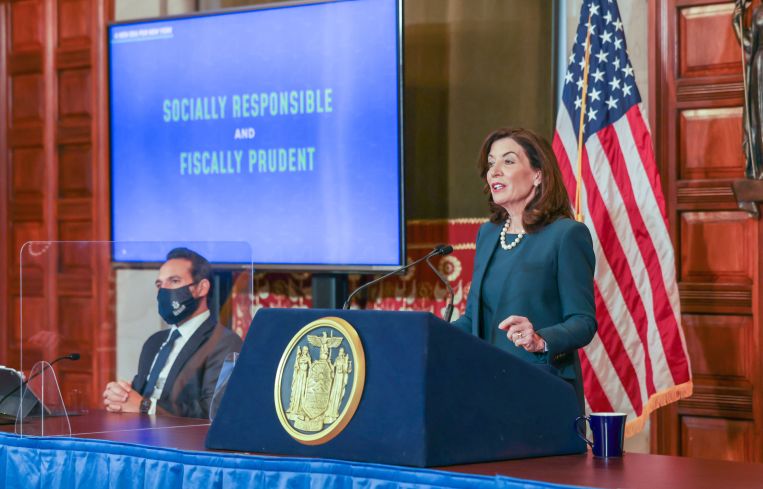Real Estate Optimistic About New York’s 421a Tax Changes
Gov. Kathy Hochul faces a divisive negotiation over the program, seen by housing advocates as free cash for developers and by real estate as crucial to affordable housing construction
By Celia Young January 21, 2022 9:10 am
reprints
What’s in a number? Well for 421a — the controversial tax incentive for residential development in New York City — it could be the fate of the city’s housing stock.
Gov. Kathy Hochul outlined her tweaks to the program on Wednesday. They would still allow developers to pay as little as no property tax for up to 35 years on residential developments that incorporate some affordable housing. The new program, dubbed “Affordable Neighborhoods for New Yorkers,” would create a new tax code, 485w, slightly increasing affordability levels while decreasing the percentage of affordable units required in a development.
It would also evaluate cooperative and condominiums units based on income affordability rather than property assessment, require permanently affordable units in large rental projects (those with 30 units or more) — rather than for the extent of the tax breaks — and slightly raise the prevailing wage for building service workers.
Affordable housing and tenant advocates have long criticized 421a, saying it produces negligible benefits for the public while allowing developers to skirt taxes. Hochul’s edits do not appear to have changed their minds.
The Legal Aid Society called the changes ‘’reform’ in name only,” and a “colossal waste of tax dollars.” City Comptroller Brad Lander opposes 421a and Hochul’s changes, saying the adjustments are a poor and financially wasteful fix for the city’s broken property tax codes, which would be better served by property tax reform and affordable housing subsidies, not tax breaks.
“We should end the 421a program,” Lander told Commercial Observer. “We should reform our property tax system to achieve parity between rentals and condos, and then we should have a program in which we offer affordable tax rates for affordable units rather than subsidize large-scale, market-rate developments in the name of affordability.”
Pretty much everyone agrees that the city’s property tax codes are highly dysfunctional, from real estate professionals like JLL’s chairman of investment sales, Robert Knakal, to ex-public officials like Alicia Glen, founder of the real estate development platform MSquared and the city’s former deputy mayor for housing and economic development. But the debate over the program tends to divide people over one simple question: Is 421a an affordable housing program or a development incentive?
The first 421a tax exemption began in the 1970s as a way to incentivize housing development, and has been revised over the years to include affordable housing and construction worker wage requirements — a battle over which stalled the program for a year in 2016, when then-Gov. Andrew Cuomo decided to let the Real Estate Board of New York (REBNY) and building and trades unions duke it out.
Hochul’s version would give fewer options to developers to meet higher affordability levels than the current program, ranging from units for those making 40 percent to 90 percent of the area median income (AMI), rather than 40 to 130 percent in the current program. For context, a single person making between $33,440 per year (40 percent AMI) to $75,240 per year (90 percent AMI) or less would qualify under Hochul’s program. A family of four with an income up to $107,370 would qualify as well, according to the New York City Department of Housing Preservation & Development (HPD).
REBNY supports Hochul’s version of 421a, and the real estate industry at large has backed her campaign in the 2022 governor’s race. Hochul has raised about $21.6 million for her campaign so far, with real estate professionals making up many of her larger contributions, like $69,700 from Vornado Realty Trust’s Steven Roth, at least $50,000 from Related Companies’ Stephen Ross, $18,000 from the CEO of Rudin Management Company, William Rudin, and $10,000 from Samuel Savarino, a western New York developer, according to campaign finance disclosures.
“The governor’s proposal provides the private sector with an important tool for producing rental housing at deeper levels of affordability permanently,” REBNY President James Whelan said in a statement.
The 421a program is extremely popular among developers because it lowers the cost of constructing residential buildings in the city, according to Patrick Sullivan, a lawyer at Kramer Levin who represents developers in zoning and municipal law. He said he’s seen 421a used in every rental building that he’s worked on since the latest version of the program went into effect in 2017.
Without the program, the city wouldn’t see much development at all because the city’s tax burden is so high, said Brett Gottlieb, a lawyer at Herrick Feinstein. As a result, the city isn’t really losing property tax revenue through 421a, because it wouldn’t have collected those taxes in the first place.
“There’s really not another good option that’s out there in terms of creating affordable housing,” said Gottlieb. “Developers, like them or hate them, they’re not going to be altruistic and just set aside 25 percent of their units for affordable housing just for the heck of it. There is going to have to be an economic incentive. And if there’s not, they will develop elsewhere.”
Lander argues the city would be better served by affordable housing subsidies — when the city directly pays developers for the cost of including affordable units, rather than subsidizing an entire development, which includes market-rate apartments. Subsidies cost the city less, he added, since the 421a program ran the city an estimated $1.6 billion in lost property tax revenue in the 2020 fiscal year, according to the city’s Department of Finance.
MSquared’s Glen, however, said 421a abatements are more efficient because property tax revenue is allocated to a variety of city services, meaning lost property tax revenue wouldn’t necessarily be earmarked for affordable housing even if it was collected. The 421a program also gets affordable housing into neighborhoods that would otherwise avoid it, she added.
Where affordable housing is located became a hot-button issue in previous versions of the tax incentive. Most of the city’s affordable housing is concentrated in low-income areas, which can concentrate poverty and worsen the lives of affordable housing residents, according to the New York City Independent Budget Office.
That disparity came to light when Extell Development’s One57 development — a luxury ultra-thin skyscraper on Billionaires’ Row — benefited from an early version of the 421a tax abatement despite having no affordable units on the property, according to the IBO. Instead, Extell built 66 affordable units in the Bronx in exchange for the tax incentives expected to save the developer and uber-wealthy residents $65.6 million over 10 years. (Extell’s Gary Barnett also donated $300,000 to Cuomo while he was considering renewing the tax benefit, a 2013 investigation found.)
“It was outrageous — that’s why we got rid of condos. It was absolutely outrageous,” Glen said about One57’s use of 421a. “We got rid of it all [in 2017] except for some very small carve-outs for [properties with] 30 units and under. I don’t think one deal has been done since then, because it was really impossible. It was a massive victory for the people to get rid of all that.”
The 2017 version of 421a removed that loophole that benefited luxury condos, Glen added, and, while Hochul’s proposed changes would apply to condos and co-ops to increase homeownership in the city, it would require those condo and co-op developments to be sold or rented at 130 percent of the area median income. A single person making at most $108,680 a year would qualify for the affordable condo or co-op, and a family of four making at most $155,090 a year would qualify as well, per the HPD.
Hochul’s proposal would also loosen requirements to pay building servicers a prevailing wage — but that change was a drafting error, according to Lander. The previous program required the prevailing wage for workers in any building with more than 30 units, while the new program was written to only require that mandatory wage for workers in buildings with more than 300 units.
Hochul plans to correct the proposal with an amendment so that workers in buildings with more than 30 units would keep the same prevailing wage protections as in the current program. Her proposal also increases the prevailing wage by a few dollars, from $60 per hour in Manhattan to $63, and $45 per hour in Brooklyn and Queens to $47.25.
The proposed changes are unlikely to pass without adjustments, Glen said. The 421a revisions are part of Hochul’s executive budget proposal, which will be open to public review through legislative hearings before a budget can be passed by an April 1 deadline.


